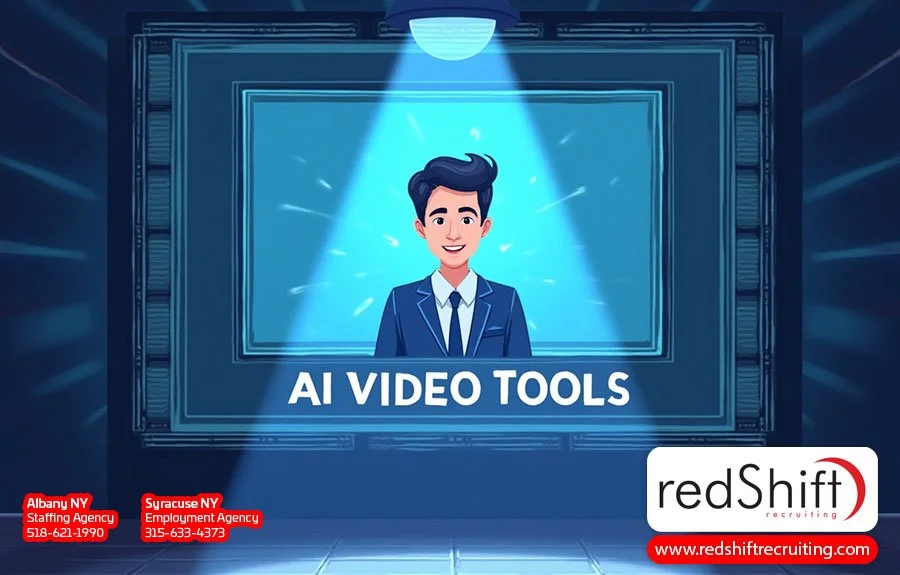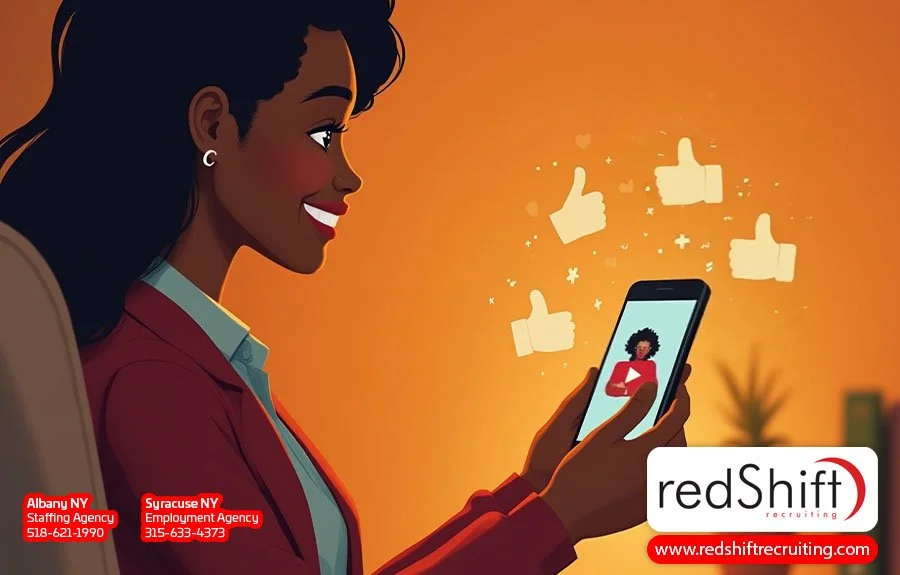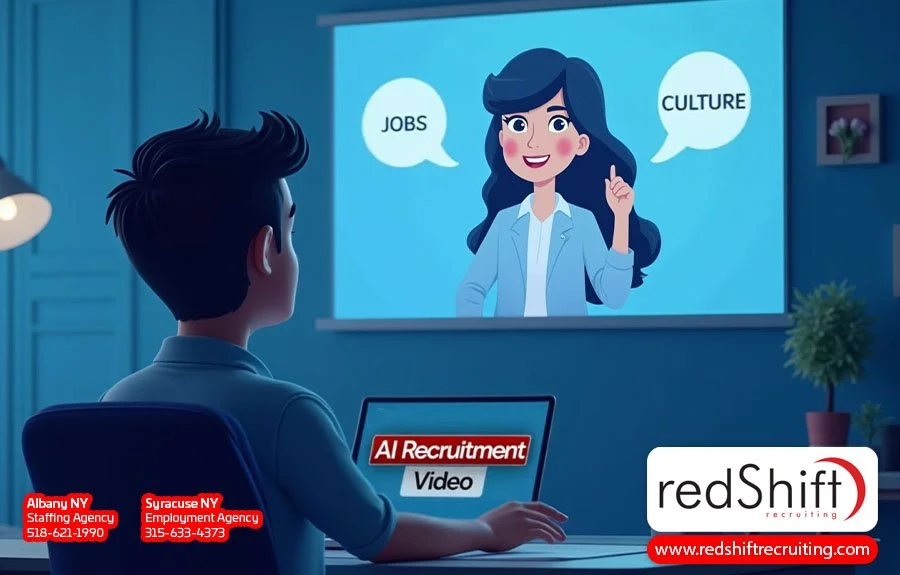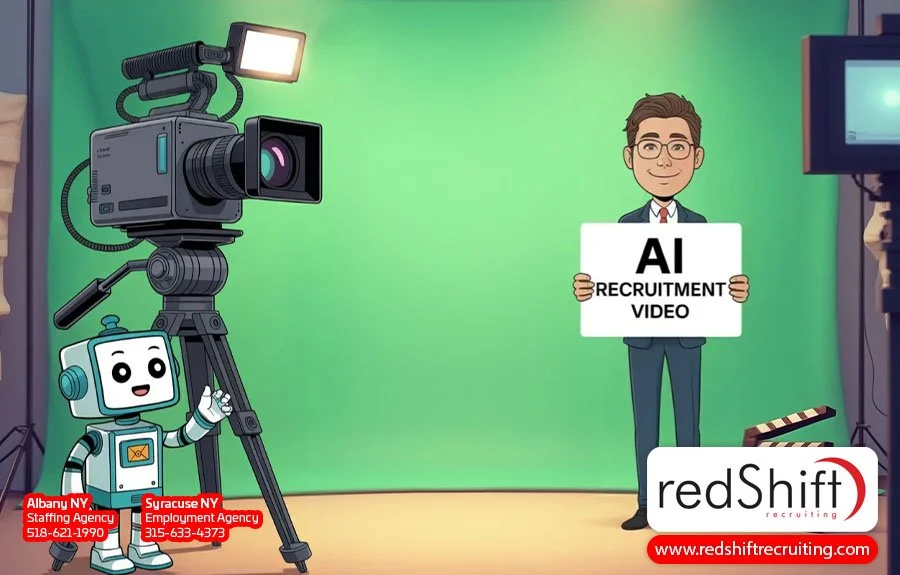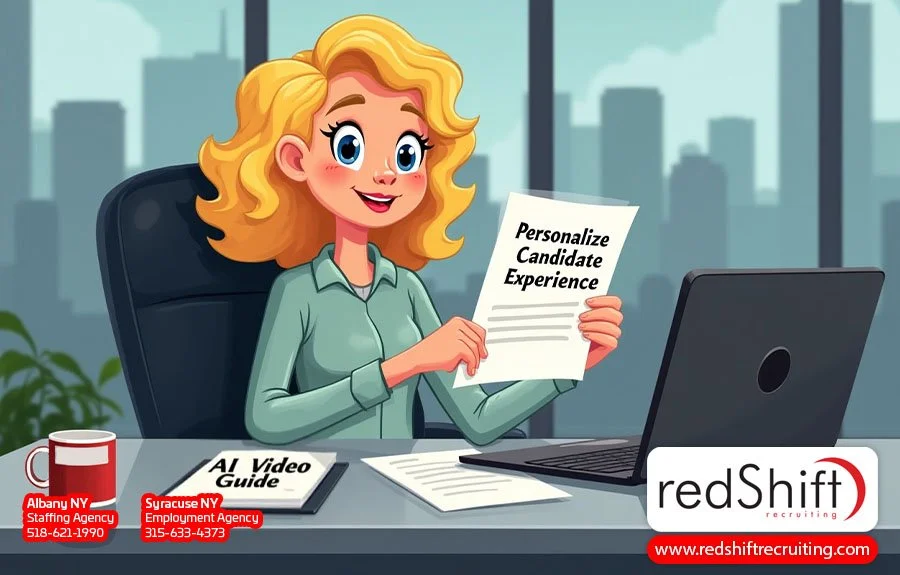How AI Video Tools Are Changing Recruitment Marketing
Most job postings look the same: a wall of text, a stock photo, maybe a logo. But think about the last thing that caught your eye while scrolling — it probably wasn’t text, it was a video. Candidates feel the same way: they want more than bullet points; they want a sense of your workplace and your values. AI video tools let employers move beyond static ads to create culture clips, job previews, and branded content that tell their story quickly and affordably. Here’s how AI video tools are changing recruitment marketing — and what that means for hiring today.
What AI Video Tools Can Do
Video is one of the most effective ways to capture attention in recruiting, but it’s also one of the hardest to pull off well. Companies usually face two extremes: either spend big on a production team with actors, cameras, and editors, or try to cobble something together in-house with shaky phone footage and limited editing skills. For many, both options are out of reach: one too expensive, the other too unpolished to represent their brand.
Today’s generative AI tools are changing all that, making video creation accessible to any hiring team. Powered by artificial intelligence and machine learning, these advanced AI systems transform short text prompts into professional-looking content in minutes. Instead of hiring a crew or relying on generic stock footage, recruiters and marketers can use intuitive AI platforms to generate clips that highlight culture, showcase roles, or support outreach.
This technology unlocks video as a practical option for recruiting teams of all sizes. Culture clips, job previews, or branded content can now be produced without big budgets or long timelines, making video creation a realistic addition to the recruiter’s box of AI recruitment tools.
Some popular platforms include:
Google VEO: Cinematic quality, smooth motion, realistic details, strong for polished employer branding
OpenAI Sora: Longer, more complex video generation with multiple characters and dynamic scenes
Runway Gen-2: Versatile, creative, and often used for social media-style clips.
Synthesia: Avatar-based video with realistic presenters, useful for hiring manager messages or onboarding previews.
HeyGen: Similar to Synthesia, strong for personalized outreach or explainer-style clips.
Pika Labs: Fast, flexible video creation suited for short, engaging content.
These and similar platforms are opening up video as a practical, everyday resource for recruiting teams, rather than a luxury for large corporations. AI-powered video opens the door to more authentic, frequent, and tailored storytelling — the kind of content that connects with candidates and strengthens an employer brand.
Comparing AI Video to Traditional Recruitment Video
Video can be a powerful recruiting tool, but producing it has traditionally forced teams to choose between spending thousands on a polished production (often $1,500 to $7,000 per finished minute) or making do with shaky DIY footage that doesn’t reflect the brand well.
AI video flips the script, replacing complex shoots and long edits with on-demand creation through AI platforms. Clips that once took weeks can now be produced in hours using subscriptions or credits, with no need for specialized production expertise.
The speed and accessibility of these tools open opportunities for scalability that traditional video couldn’t match. Instead of investing heavily in a single polished clip, companies can test variations, tailor content to different roles, and refresh messaging as often as needed, all without the cost of reshoots.
Equally important, AI video reduces back-end effort. By cutting down on administrative tasks, avoiding repetitive editing loops, and smoothing out other routine tasks, these tools help streamline recruitment processes. Recruiters can spend less time wrestling with logistics and more time focusing on hiring strategy and candidate engagement.
Using AI Video for Recruiting and Candidate Engagement
AI video isn’t just about making content cheaper and faster; it’s about using it to connect with candidates more effectively and strengthen the overall recruitment strategy. From showcasing culture to improving candidate engagement, here are some of the most practical applications for recruiting teams and talent acquisition leaders:
Employer Branding: Create authentic “day in the life” videos, virtual office tours, or values-driven storytelling that highlight your employer brand and employer value proposition. These videos help employers reach diverse talent pools and appeal to top talent by presenting a clear, engaging picture of workplace culture.
Job Ads & Postings: AI video tools can turn text-heavy job postings into short, dynamic clips that highlight job requirements, perks, and growth opportunities. This helps candidates quickly see if they are a good fit, improving candidate quality and reducing wasted applications. For recruiters, it’s another way to make writing job descriptions more impactful.
Candidate Outreach & Communications: Replace generic emails with personalized video introductions, hiring manager messages, or testimonial-style clips. These forms of candidate communications feel more human and help nurture relationships with potential candidates earlier in the talent acquisition process.
Candidate Experience: Today’s candidates expect video-first content that mirrors the formats they already consume on sites like TikTok, Instagram, LinkedIn, or YouTube. Employers who don’t adapt to this expectation risk losing their competitive advantage, instead appearing outdated and missing opportunities to connect with younger talent pools. Providing short, authentic clips shows that employers understand candidate behavior and preferences, which builds trust and keeps the hiring process moving.
Social Media Campaigns: AI technology makes it possible to create large volumes of video for Reels, Shorts, or LinkedIn posts. This not only increases reach but also gives talent acquisition professionals the ability to A/B test content, improve candidate engagement, and identify messaging that helps predict candidate success.
Explainers & Role Previews: Use short clips to simplify complex roles or projects, showing what the job actually involves. This clarity improves candidate matching by helping qualified candidates self-select into roles while filtering out those who aren’t a good match.
📹 Example in action: Here’s a short AI-generated recruitment video describing a Data Scientist role, created with Synthesia. It shows how employers can bring job postings to life and give candidates a quick, engaging preview of a role (without a full production team).
When used well, AI video can help employers be more visible, relevant, and relatable in a crowded market. Teams that embrace video as part of recruitment marketing not only stand out today but also remain competitive and future-proof their hiring strategies.
Key Benefits of Using Video-Based AI Recruitment Tools
AI video isn’t just a creative shortcut; it offers tangible benefits for recruiters and employers. The biggest advantages include:
Saving Time and Money: AI video is often more efficient and cost-effective, removing the need for expensive shoots, editing, and reshoots. What once took weeks of effort and outside vendors can now be done in hours with AI tools, opening up video recruitment marketing to teams that never had the budget or in-house expertise before.
Scaling Content Creation: Teams can quickly generate multiple video versions tailored to different roles, departments, or demographics. This flexibility makes it easier to align content with specific hiring needs while still keeping human oversight and brand consistency.
Expanding Reach and Engagement: Video consistently outperforms static posts for visibility and interaction, supporting candidate sourcing efforts by helping human recruiters connect with broader audiences and improve candidate engagement.
Creating Authentic, Customized Content: Instead of relying on generic stock footage, employers can create on-brand, role-specific videos that reflect workplace values. This customization shows candidates who you really are, building stronger connections and making your employer brand more memorable through unique images.
Optimizing Through Data: With AI video, employers can quickly A/B test variations of role previews, branding messages, and other content to see which messages resonate most with candidates. As AI applies data analysis to highlight engagement patterns, recruiters can refine content and pair those insights with predictive analytics to forecast campaign success, all while keeping human decision-making at the center.
Standing Out in the Market: Video helps employers stand out in crowded markets, especially when paired with AI recruiting tools or other forms of recruiting automation. Using video as part of AI recruitment strategies signals innovation and helps organizations maintain a competitive edge.
Together, these benefits show how incorporating AI into recruitment marketing can improve and future-proof your hiring strategy while still maintaining the human element.
Challenges and Ethical Risks of AI Video in Recruiting
AI video opens new possibilities, but it also comes with challenges that employers and recruiting teams need to manage carefully:
Authenticity & Trust: Some AI-generated clips risk looking too artificial or “uncanny,” which can undermine credibility with candidates. Striking the right balance requires strong AI skills, human insight, and often some basic knowledge of video editing to make small adjustments that ensure the final content feels polished and genuine.
Bias & Representation: Any AI model reflects the data it was trained on. Without careful human oversight, outputs may reinforce stereotypes or overlook diversity.
Quality Control: Even with strong AI efficiency, content still needs to align with brand standards and messaging. Regular reviews help ensure videos reflect the company accurately and fairly. In many organizations, this means collaboration between recruiting and marketing, with recruiters shaping the message and marketing teams ensuring the final product stays consistent with the employer brand.
Copyright & Ownership: Legal questions remain around who owns AI-generated media and how it can be used. Employers should confirm usage rights before incorporating video into the recruiting process.
Deepfakes & Misinformation: As AI use expands, so does the potential for bad actors to misuse such tools. Responsible deployment and clear communication are key to maintaining trust.
Over-Reliance and Adoption Risks: While AI can save time and reduce repetitive tasks, leaning on it too heavily risks producing generic, impersonal content that weakens the employer brand. Over-reliance on AI tools may lead teams to neglect the storytelling and cultural insights that make recruitment marketing meaningful. At the same time, rushing into AI adoption without clear policies or governance can expose employers to major legal or compliance issues. Leading companies set thoughtful guidelines before scaling AI video efforts to ensure it supports, rather than undermines, recruitment efforts.
Responsible AI Use: Employers should consider transparency and disclosure, including when to tell candidates that content is AI-generated. Clear policies on ethics, communication, and usage will help ensure AI strengthens, rather than undermines, recruitment.
By addressing these risks early — from authenticity to adoption policies — employers can experiment with AI video confidently and set the stage for responsible, effective use.
Getting Started With AI Video in Recruiting
Adopting AI video doesn’t mean overhauling your entire recruiting process overnight. The best approach is to start small and build confidence step by step:
Pilot a Single Project: Test AI video on one role — for example, turning a text-heavy job posting into a short culture clip. The goal isn’t perfection but gathering quick feedback to guide whether to expand.
Experiment Across Platforms: Different tools and channels work best for different needs. Try a “day in the life” snippet on LinkedIn or a short role explainer where you normally post jobs on job boards. Use different formats and messaging styles to see which connect best with specific candidate groups.
Partner for Quality: Professional recruiters bring experienced human judgment and messaging insight, while marketing professionals add human expertise in polish and brand consistency. Collaborating with experts keeps content authentic.
Track and Iterate: Use performance data to refine campaigns. Whether it’s A/B testing AI-assisted messaging or analyzing engagement, the key is to adjust based on what resonates with candidates.
Before scaling, set a modest testing budget, establish basic internal guidelines for AI use, and consider employing someone with at least light editing experience to polish outputs. Even small pilots (when done thoughtfully) can give recruiting teams the insight and confidence to integrate AI video into their long-term strategies.
Frequently Asked Questions
What Are the First Steps to Getting Started With AI Video in Recruitment?
Start small with a pilot project — for example, turning a text-heavy job description into a short culture clip. Test different AI tools and channels (LinkedIn, job boards, social media) to see what resonates. Let recruiters shape messaging while marketing or design teams handle polish for authenticity. Track engagement with A/B tests and click-throughs, then expand gradually with a modest budget and clear internal guidelines. This step-by-step approach makes adoption manageable and prevents overwhelming the hiring process with too much change at once.
Are AI-Generated Recruitment Videos Perceived as Authentic by Candidates?
Authenticity matters more than polish. Poorly executed AI videos often look unnatural, but when guided by thoughtful messaging and human recruiters' input, they can feel genuine and relatable. Avoid generic stock-style outputs and highlight culture, values, or role previews. Transparency also helps, and some companies choose to disclose that videos are AI-generated, which can build trust rather than diminish it. In short: authenticity depends less on the technology itself and more on how recruiters apply human judgment and storytelling to shape the output.
How Can AI Video Tools Personalize Content for Different Candidate Demographics?
AI video makes it easy to tailor content for different groups, from early-career talent to senior professionals. By drawing on marketing and candidate data, talent acquisition professionals can adjust tone, messaging, or visuals to align with different roles. For example, one clip may emphasize growth opportunities for recent graduates, while another highlights leadership culture for experienced hires. Done carefully, this boosts potential candidate engagement and diversity without falling into stereotypes or relying on a one-size-fits-all model.
What Legal or Compliance Concerns Should Employers Consider With AI Video?
AI video raises questions around ownership, rights, and compliance. Ownership of AI-generated clips is still a legal gray area, and usage rights can vary by platform. Some platforms claim partial ownership of generated media, so employers should review terms carefully. Bias is another concern, as some AI outputs may reinforce stereotypes that could expose companies to legal or reputational risk. Transparency matters too, and in some regions, disclosure that content is AI-generated may be required. Finally, organizations should implement governance policies to guide compliant and ethical AI use.
How Can Companies Measure ROI From AI Video in Recruiting?
Measuring ROI starts with clear goals, whether stronger sourcing, better engagement, or improved candidate matching. Key metrics include views, click-throughs, and application rates, compared against historical hiring data. Predictive analytics can forecast campaign success, while recruiter insight ensures human judgment guides results. Some platforms can even rank candidates based on engagement with job postings, providing a valuable benchmark of your campaign's effectiveness. Beyond numbers, ROI should also capture qualitative gains like improved relationship building with candidates or stronger employer brand visibility. The key is blending data-driven insights with recruiter expertise to understand both immediate impact and long-term value.
Conclusion: A New Era for Recruitment Marketing
With the right approach, AI video can be a practical way for employers to bring job postings, culture clips, and role explanations to life. These tools save time and money while giving recruiting teams new ways to connect with candidates. But success depends on balance: while AI can analyze patterns and streamline production, effective storytelling still requires human judgment and human expertise to feel authentic and on-brand.
Used thoughtfully, AI video can help employers source and match candidates more effectively by clarifying job requirements and creating content that resonates across platforms, from job boards to social media. It also makes new types of content accessible to organizations without large budgets or staff with formal education in video production. The companies that thrive will be those that adopt AI responsibly, pair it with human insight, and use it to build a scalable, ethical, and future-proof recruitment marketing strategy.
Article Author:
Ashley Meyer
Digital Marketing Strategist
Albany, NY

